jump start AUDI S4 2015 Owners Manual
[x] Cancel search | Manufacturer: AUDI, Model Year: 2015, Model line: S4, Model: AUDI S4 2015Pages: 304, PDF Size: 74.86 MB
Page 5 of 304
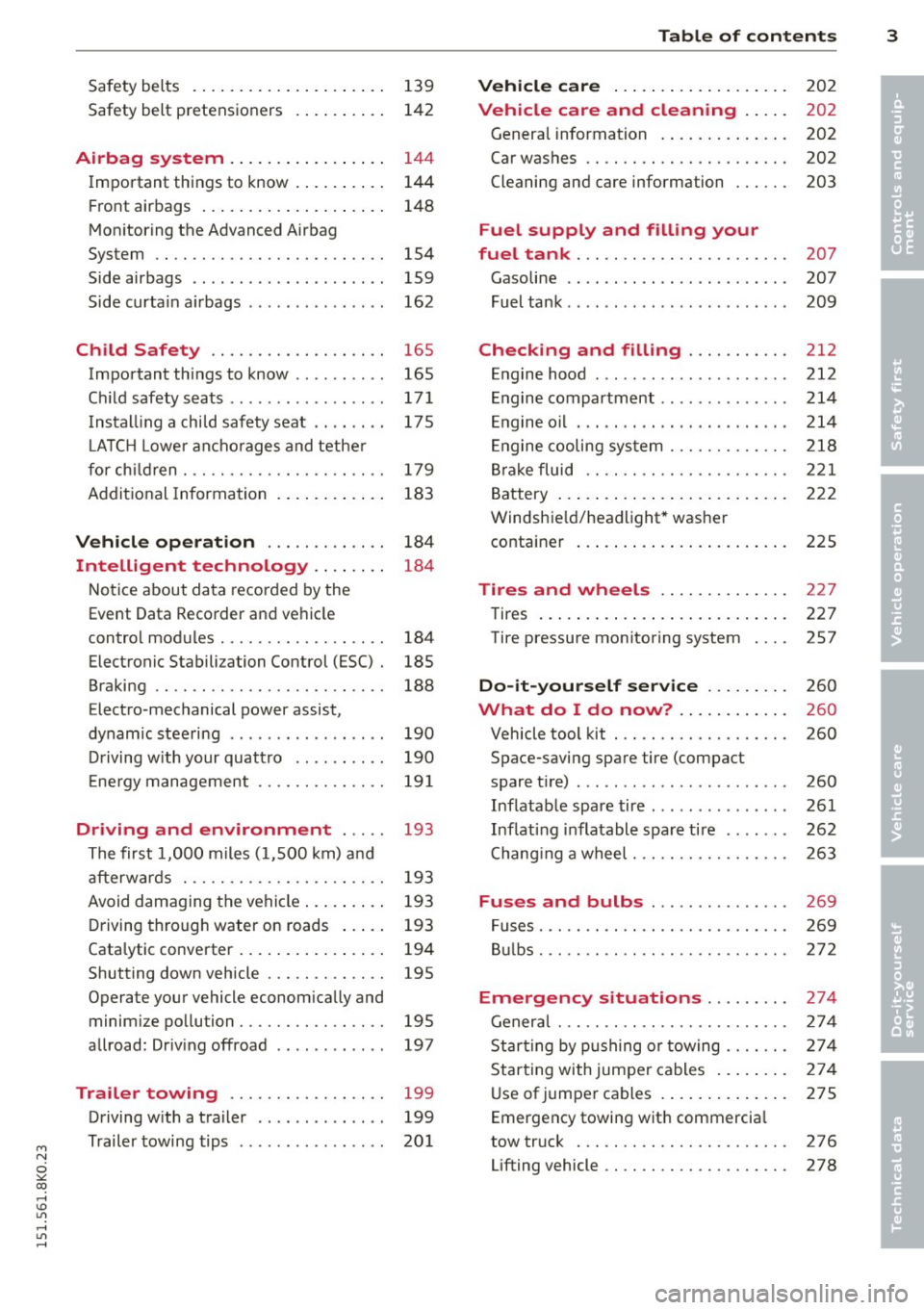
"" N
0 ::.,: co ,...., \!) 1.1'1 ,...., 1.1'1 ,....,
Safety belts . . . . . . . . . . . . . . . . . . . . . 139
Safety belt pretensioners . . . . . . . . . . 142
Airbag system . . . . . . . . . . . . . . . . . 144
Important things to know . . . . . . . . . . 144
Front airbags . . . . . . . . . . . . . . . . . . . . 148
Monitoring the Advanced Airbag
System . . . . . . . . . . . . . . . . . . . . . . . . . 154
Side airbags . . . . . . . . . . . . . . . . . . . . . 159
Side curtain airbags . . . . . . . . . . . . . . . 162
Child Safety . . . . . . . . . . . . . . . . . . . 165
Important things to know . . . . . . . . . . 165
Child safety seats ............ .. ... 171
Installing a child safety seat .. .. .. .. 175
L ATCH Lower anchorages and tether
for child ren. ............. .. .. .. .. 179
Additional Information
183
Vehicle operation . . . . . . . . . . . . . 184
Intelligent technology . . . . . . . . 184
Notice about data recorded by the
Event Data Recorder and vehicle
control modules . . . . . . . . . . . . . . . . . . 184
Electronic Stabili zation Control (ESC) . 185
Braking . . . . . . . . . . . . . . . . . . . . . . . . . 188
Electro -mechanical power assist,
dynamic steering . . . . . . . . . . . . . . . . . 190
Driving with your quattro . . . . . . . . . . 190
Energy management . . . . . . . . . . . . . . 191
Driving and environment . . . . . 193
The first 1,000 miles (1,500 km) and
afterwards . . . . . . . . . . . . . . . . . . . . . . 193
Avoid damaging the vehicle. . . . . . . . . 193
Driving through water on roads . . . . . 193
Catalytic converter . . . . . . . . . . . . . . . . 194
Shutting down vehicle . . . . . . . . . . . . . 195
Operate your vehicle economically and minimize pollution . . . . . . . . . . . . . . . . 195
allroad: Driving offroad . . . . . . . . . . . . 197
Trailer towing . . . . . . . . . . . . . . . . . 199
Driving with a trailer . . . . . . . . . . . . . . 199
Trailer towing tips . . . . . . . . . . . . . . . . 201
Table of contents 3
Vehicle care . . . . . . . . . . . . . . . . . . .
202
Vehicle care and cleaning . . . . . 202
General information . . . . . . . . . . . . . . 202
Car washes . . . . . . . . . . . . . . . . . . . . . . 202
Cleaning and care information . . . . . . 203
Fuel supply and filling your
fuel tank . . . . . . . . . . . . . . . . . . . . . . .
207
Gasoline . . . . . . . . . . . . . . . . . . . . . . . . 207
Fuel tank . . . . . . . . . . . . . . . . . . . . . . . . 209
Checking and filling . . . . . . . . . . . 212
Engine hood . . . . . . . . . . . . . . . . . . . . . 212
Engine compartment ... ......... .. 214
Engine oil . . . . . . . . . . . . . . . . . . . . . . . 214
Engine cooling system . . . . . . . . . . . . . 218
Brake fluid . . . . . . . . . . . . . . . . . . . . . . 221
Battery ... .. .... .. ............. .
222
Windshield/headlight* washer container . . . . . . . . . . . . . . . . . . . . . . . 225
Tires and wheels . . . . . . . . . . . . . . 227
Tires . . . . . . . . . . . . . . . . . . . . . . . . . . . 227
Tire pressure monitoring system 257
Do-it-yourself service . . . . . . . . . 260
What do I do now? . . . . . . . . . . . . 260
Vehicle tool kit . . . . . . . . . . . . . . . . . . . 260
Space-saving spare tire (compact
spare tire) . . . . . . . . . . . . . . . . . . . . . . . 260
Inflatable spare tire . . . . . . . . . . . . . . . 261
Inflating inflatable spare tire . . . . . . . 262
Changing a wheel. . . . . . . . . . . . . . . . . 263
Fuses and bulbs . . . . . . . . . . . . . . . 269
Fuses..... .... .... .............. 269
Bulbs. . . . . . . . . . . . . . . . . . . . . . . . . . . 272
Emergency situations ... ... .. . 274
General... .... .................. 274
Starting by pushing or towing . . . . . . . 274
Starting with jumper cables . . . . . . . . 274
Use of jumper cables . . . . . . . . . . . . . . 275
Emergency towing with commercial
tow truck . . . . . . . . . . . . . . . . . . . . . . . 276
Lifting vehicle . . . . . . . . . . . . . . . . . . . . 278
•
•
Page 216 of 304

214 Checking and filling
Engine compartment
Engine compartment
These are the most important items that you can check.
Fig. 182 Typical layout for containers and eng ine o il filler cap
(D Eng ine o il filler cap ("1::::r.) . . . . . 216
@ Jump start point(+) under a cov-
er .. .. .... ... ....... .... ..
224, 275
@ Bra ke fluid reservo ir (0)) . . . . . 221
@ Coolant expansion tank (-L) . . . 219
® Jump start point(-) with hex
head sc rew ..... .......... ..
224, 275
® W indshield/headlight* washer
. (" ') container o ....... . ... .. . 225
The pos ition o f the engine o il fi lling hole
¢ fig . 182 (item @) can differ depending on
the eng ine design.
A WARNING
Before yo u check anything in the engine
compartment, always read and heed all
WARNINGS
¢ .&. in Working in the engine
compartment on page 212.
-
Engine oil
· Engine oil specifications
The engine oil used must conform to exact
specifications.
The service interval disp lay in the instrument
cluster of your vehicle will inform you when it
is time for a n oil change . We recommend that
you have your oil changed by an authorized
Audi Se rv ice Adv isor.
If you have to top off the o il between o il
changes, use the Audi o il quality standard
specified in the tab le.
Audi oil quality standard
Gasoline
VW 502 00 or
engine vw 504 00
Page 226 of 304
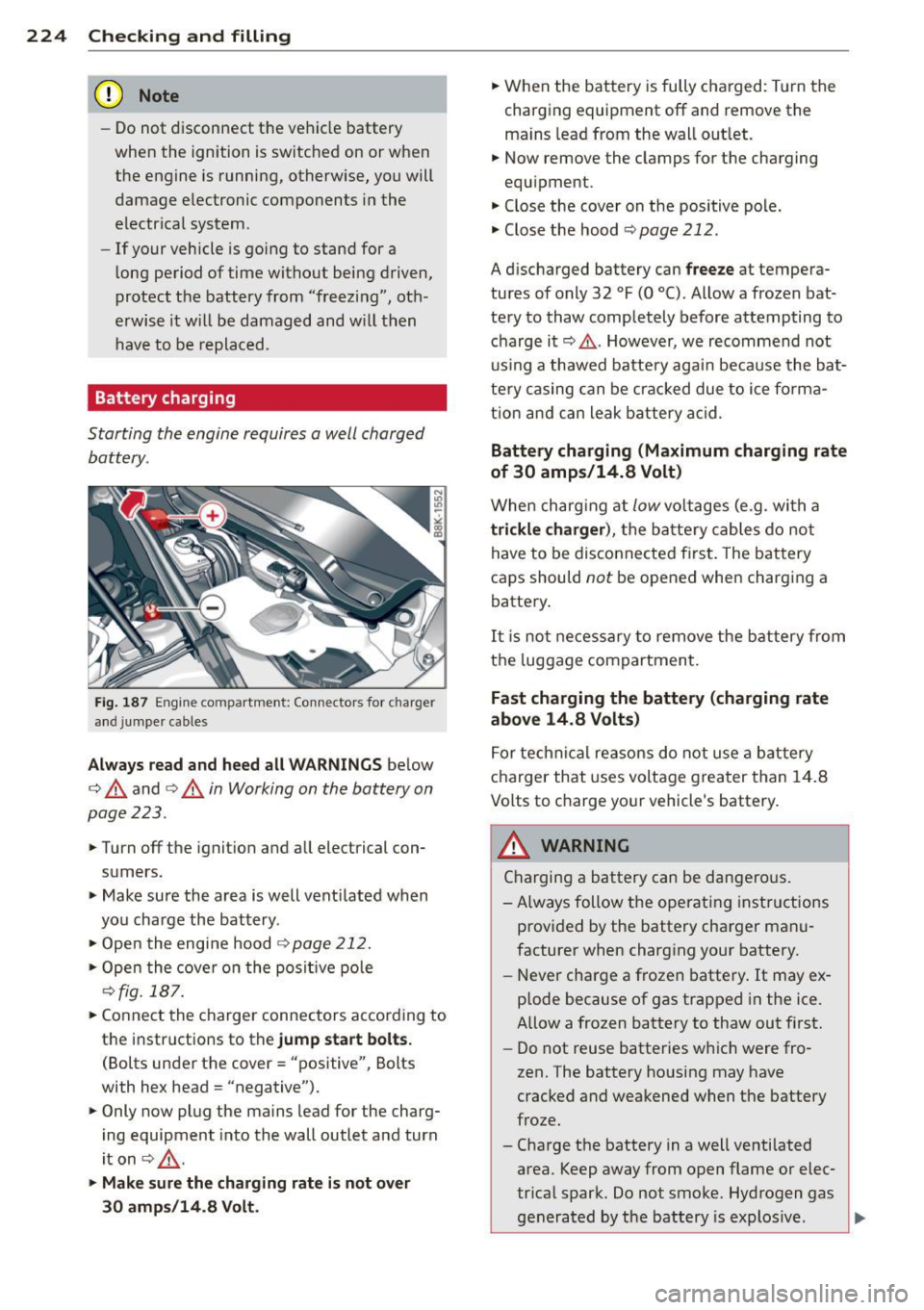
224 Checking and filling
(D Note
- Do not disconnect the vehicle battery
when the ignition is switched on or when
the engine is running, otherwise, you will
damage e lectronic components i n the
electrical system.
- If your vehicle is going to stand for a
long period of time without being driven,
protect t he battery from "freezing", oth
e rwise it w ill be damaged and w ill then
have t o be repla ced.
Battery charging
Starting the engine requires a well charged
batt ery.
Fig. 187 Eng ine compartment: Connectors for charger
a nd jumper cables
Always read and heed all WARNINGS below
c::> & and c::> & in Working on the battery on
page 223 .
•Turnoff th e ignit ion and all electrical con
sumers.
• Make sure the area is well vent ilated when
yo u cha rge the battery .
• Ope n the engi ne hood
i=!.> page 2 12.
• Open the cove r o n the pos it ive pole
e!.>fig. 187.
• Connect the charger connectors according to
t h e instr uctions to the
jump start bolts.
(Bo lts under the cover = "positive", Bolts
with hex head= "negative").
• Only now plug the mains lead for the charg
i ng equipment into the wall outlet and turn
i t on
c::> .&,. .
• Make sure the charging rate i s not over
30 amps /14.8 Volt .
• When the battery is fully cha rged: Turn the
charging equipment off and remove the
mains lead from the wall out let.
• Now remove the clamps for the charging
equ ipment.
.,. Close the cover on the positive pole .
.,. Close the hood
c::> page 212.
A discha rged battery can freeze at tempera
tures of only 32 °F (0 °C). Allow a frozen bat
tery to thaw comp letely before attempting to
charge i t
c::> .&.. However, we recommend not
u sing a thawed batte ry aga in because the ba t
te ry casing can be c racked due to ic e f orma
t io n an d can leak ba ttery a cid.
Battery charging (Maximum charging rate
of
30 amps/14.8 Volt)
When ch arg ing at low vo lta ges (e.g. wi th a
trickle charger ), the ba tte ry cables do not
have to be disconnected f irs t. T he bat tery
caps should
not be opened when charg ing a
battery .
It is no t necessa ry to remove the b att ery from
t h e luggage com partmen t.
Fast charging the battery (charging rate
above 14.8 Volts)
F or te chnica l re asons do not u se a batt ery
ch arger that uses voltage greater than
14 .8
Volts to c harge yo ur vehicle's battery.
A WARNING
.------
C harging a battery can be dan gero us.
-A lways follow t he operati ng inst ru ctions
p rovi ded by the battery charger manu
facturer when charg ing your battery.
- Never charge a frozen batte ry . I t may ex
p lode because of gas trap ped in the ice.
A llow a frozen battery to thaw out f irst.
- Do not reuse batteries w hich were fro
zen. The battery housing may have
cracked and weakened w hen the battery
froze .
- Charge the battery in a we ll ventilated
area. Keep away from o pen flame or elec
tr ica l spark. Do not s moke. Hyd rogen gas
ge nera ted by t he battery is explos ive .
Page 276 of 304
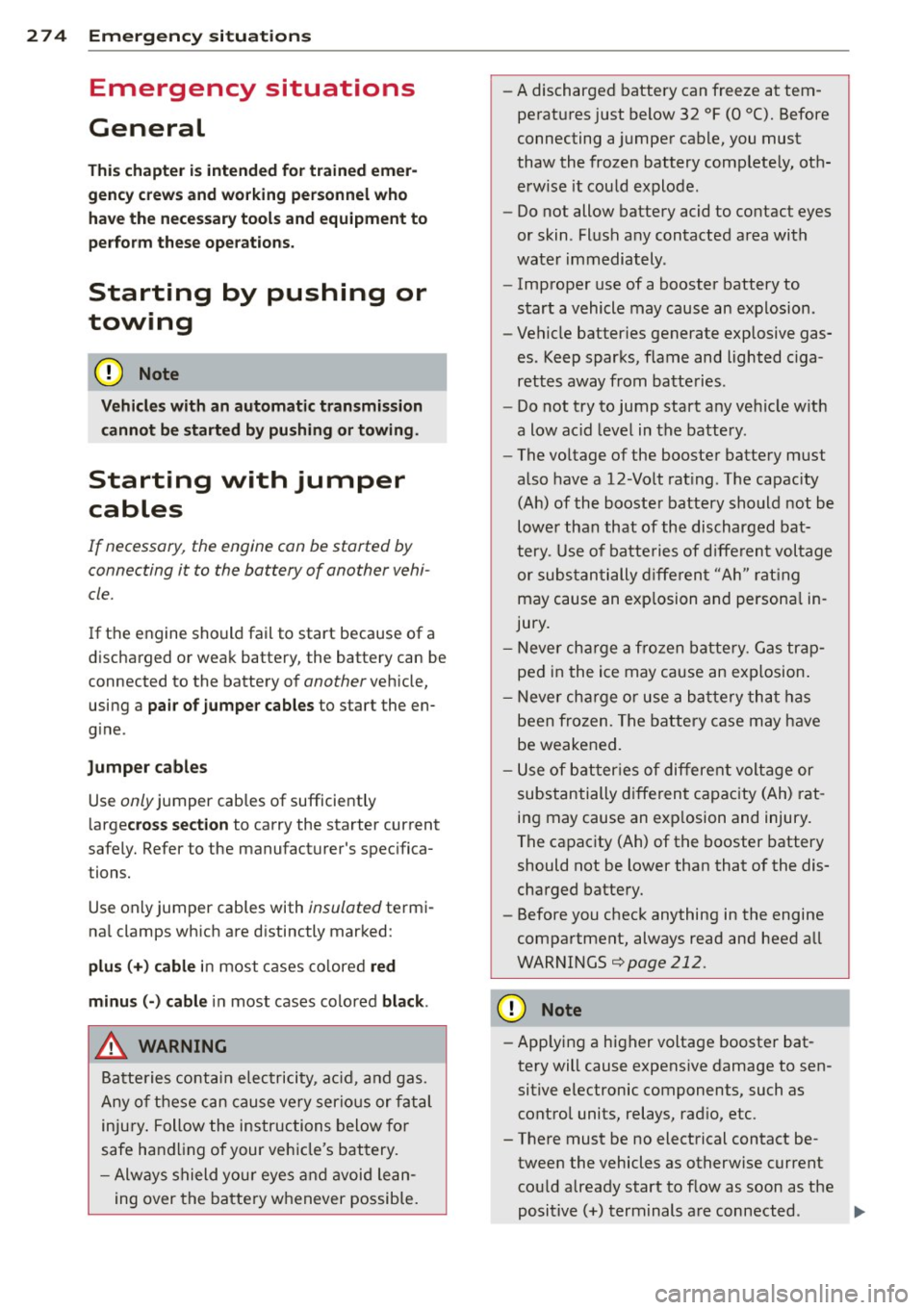
2 7 4 Emergency situations
Emergency situations
General
This chapter is intended for trained emer
gency crews and working per sonnel who
have the necessary tools and equ ipment to
perform these ope rations.
Starting by pushing or
towing
Q;) Note
Vehicle s with an automati c transmission
cannot be started by pushing or towing .
Starting with jumper
cables
If necessary, the engine can be started by
connecting it to the battery of another vehi
cle.
If the engine should fail to start because of a
discha rged or wea k batte ry, the battery can be
connected to the battery o f
another vehicle,
using a
pair of jumper cables to start the en
g ine .
Jumper cables
Use only jumper cab les of sufficiently
large cross section to carry the starter cur rent
safely. Refer to the manufact urer's spec ifica
ti ons.
Use on ly jumper cables with
insulated te rmi
na l clamps wh ic h are d istinctly mar ked :
plus (+) cable in most c ases co lore d red
minu s (-) cable
in most cases colored black .
A WARNING
Batterie s cont ain e lec tricity, a cid, a nd gas.
A ny o f these c an ca use ve ry ser io us or f atal
in ju ry . F ollow the i nstruc tio ns below for
safe ha ndling of your ve hicle's bat tery.
- Alw ay s sh ield yo ur eye s and a vo id le an
ing over the batte ry w henever p ossib le . -
A discharged battery can freeze at tem
pe rat ures just below 32 °F (0 °C). Before
connecting a jumper cable, you must
thaw the fr ozen battery complete ly , ot h
e rwise it cou ld explode.
- Do not allow batte ry acid to contact eyes
or skin . Fl ush any contacted a rea wi th
wate r im media tely.
- Imp roper use of a booster battery to
s tart a vehicle may cause an explosion.
- Vehicle batter ies generate explosive gas
es . Keep sparks, flame and lighted ciga
rettes away from ba tte ries .
- Do not try to jump start a ny ve hicle w ith
a low ac id leve l in the battery .
- The vo ltage of the booster batte ry m ust
a lso have a 12-Vo lt rat ing . The capacity
(A h) of the booster batte ry should not b e
lowe r than that of the discharged bat
tery . U se o f batt erie s of d iffe ren t voltage
or subs tanti ally diffe ren t "Ah" rat ing
may c ause an exp losion and person al in
ju ry .
- N ever ch arge a fr ozen bat te ry. Gas t rap
ped in the ice may ca use an ex plosion .
- N ever ch arge o r use a batt ery th at has
been fro zen. T he battery case may have
be weakened.
- Us e of batt erie s of di ffere nt vo ltag e or
substan tially differen t ca pa city (Ah) rat
i ng may cause an exp losion and injury.
T he capac ity (Ah) of the booster battery
should not be lower than that of the dis
charged batte ry.
- Before you check anything in the engine
compartment, always read and heed a ll
W ARNI NGS¢
page 212.
(D Note
- App lyi ng a hig her voltage booste r bat
tery wi ll cause expens ive damage to sen
sitive e lectronic components, such as
cont ro l units, relays, rad io, etc.
- There must be no electrical contact be twee n the vehicles as otherwise current
co uld already start to f low as soon as t he
posi tive(+) terminals a re con nected . ..,.
Page 277 of 304
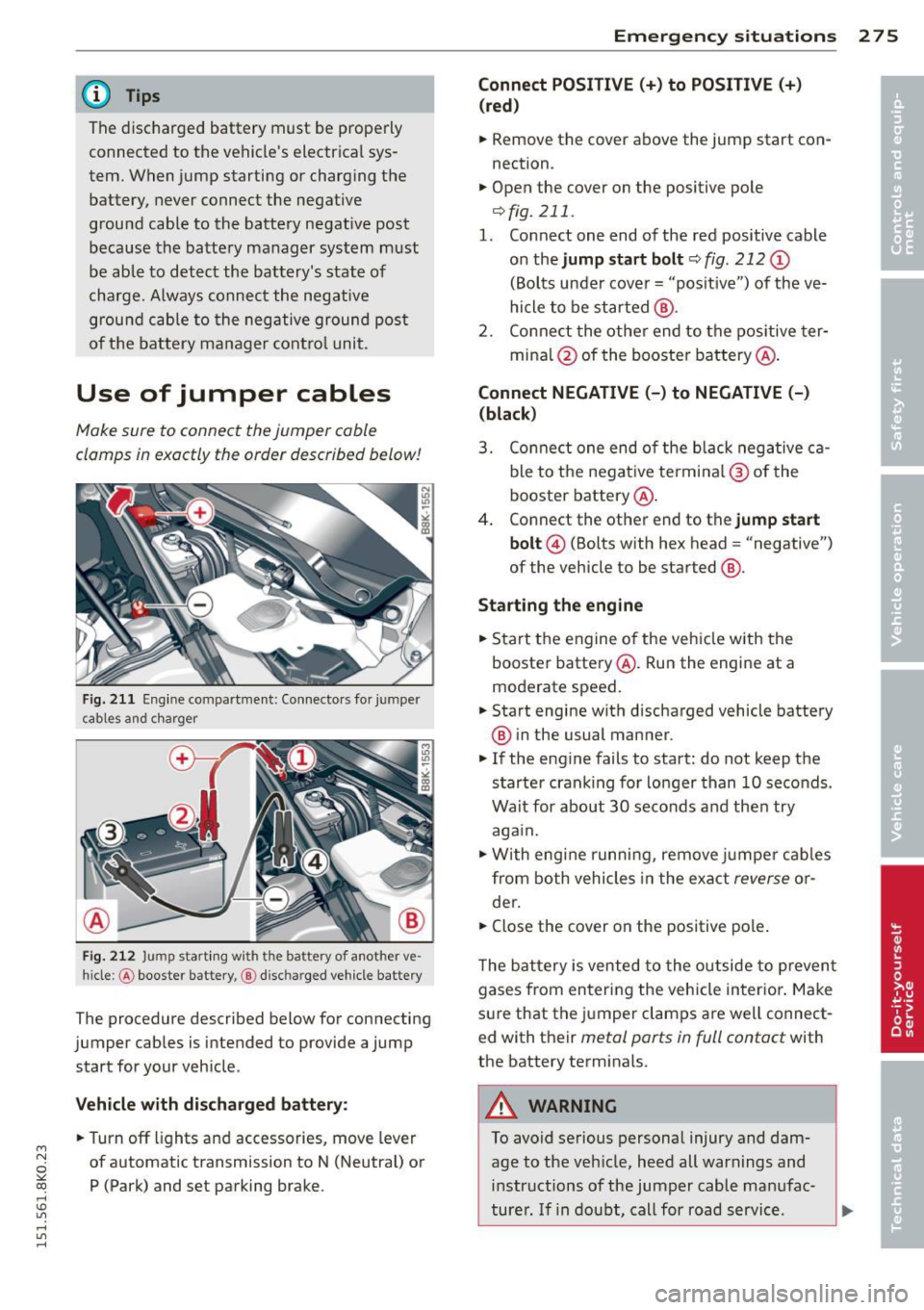
M N
~ co
rl I.O
"' rl
"' rl
@ Tips
The discharged battery must be properly
connected to the vehicle's electrical sys
tem. When jump starting or charg ing the
battery, never connect the negative
ground cable to the battery negat ive post
because the ba ttery manager system must
be ab le to detect the battery's state of
charge. Always connect the negative
g round cab le to the negative ground pos t
of t he battery manager cont ro l unit.
Use of jumper cables
Make sure to connect the jumper coble
clomps in exactly the order described b elow!
Fi g. 21 1 Eng ine co mpar tment: Co nnecto rs fo r jum per
c ab les a nd c har ge r
F ig. 212 Jump start in g w ith t he ba ttery of a not her ve ·
hi cle :@ booster battery, @ disc harged veh icle battery
The procedure described below for connecting
jumper cables is intended to provide a jump
start for your veh icle .
Vehicle with di scharged battery :
~Turnoff lights and accessories , move lever
of automatic transmission to N (Neutral) or P (Park) and set parking brake .
Emergency situ ation s 2 7 5
Connect POSITIVE(+) to POSITIVE(+ )
(red )
~ Remove the cover above the jump start con
nection .
~ Open the cover on the positive pole
¢fig . 211 .
1. Connect one end of the red positive cable
on the
jump sta rt bolt c::;, fig. 212 (D
(Bolts under cove r= "posit ive ") of the ve
hicle to be started @.
2 . Conne ct the othe r end to the pos itive ter -
mina l@ of the booster battery @.
Connect NEGATIVE (-) to NEGATIVE (-)
(black )
3. Co nnect one end o f the b lack neg ative c a
ble to the nega tive te rmi na l@ of the
booster battery @.
4 . Connect the other end to the
jump start
bolt @
(Bolts with hex head = "negative")
of the vehicle to be started @.
Starting the engine
~ Start the engine of the ve hicle with the
booste r battery @. Run the engine at a
moderate speed.
~ Start engine with d ischarged vehicle battery
® in the usual manner .
~ If the engine fails to start: do not keep t he
starter cran king for lo nger than 10 seconds .
Wait for about 30 seco nds and the n try
aga in.
~ W ith engi ne runni ng, remove jumpe r cab les
from both vehicles in the exa ct
reverse o r
der .
~ Close the cover on the positive pole .
T he b attery is vented to the o utside to p reven t
gases from en tering the veh icle in ter ior . Ma ke
s ur e that the j umper clamps a re well connect
e d with their
metal ports in full contact with
the batte ry term inals.
A WARNING
To avoid serious personal injury and dam
age to the vehicle, heed all warnings and
in structions of the jumper cable ma nufac-
turer . If i n dou bt, call for road servic e.
Ill>
Page 278 of 304
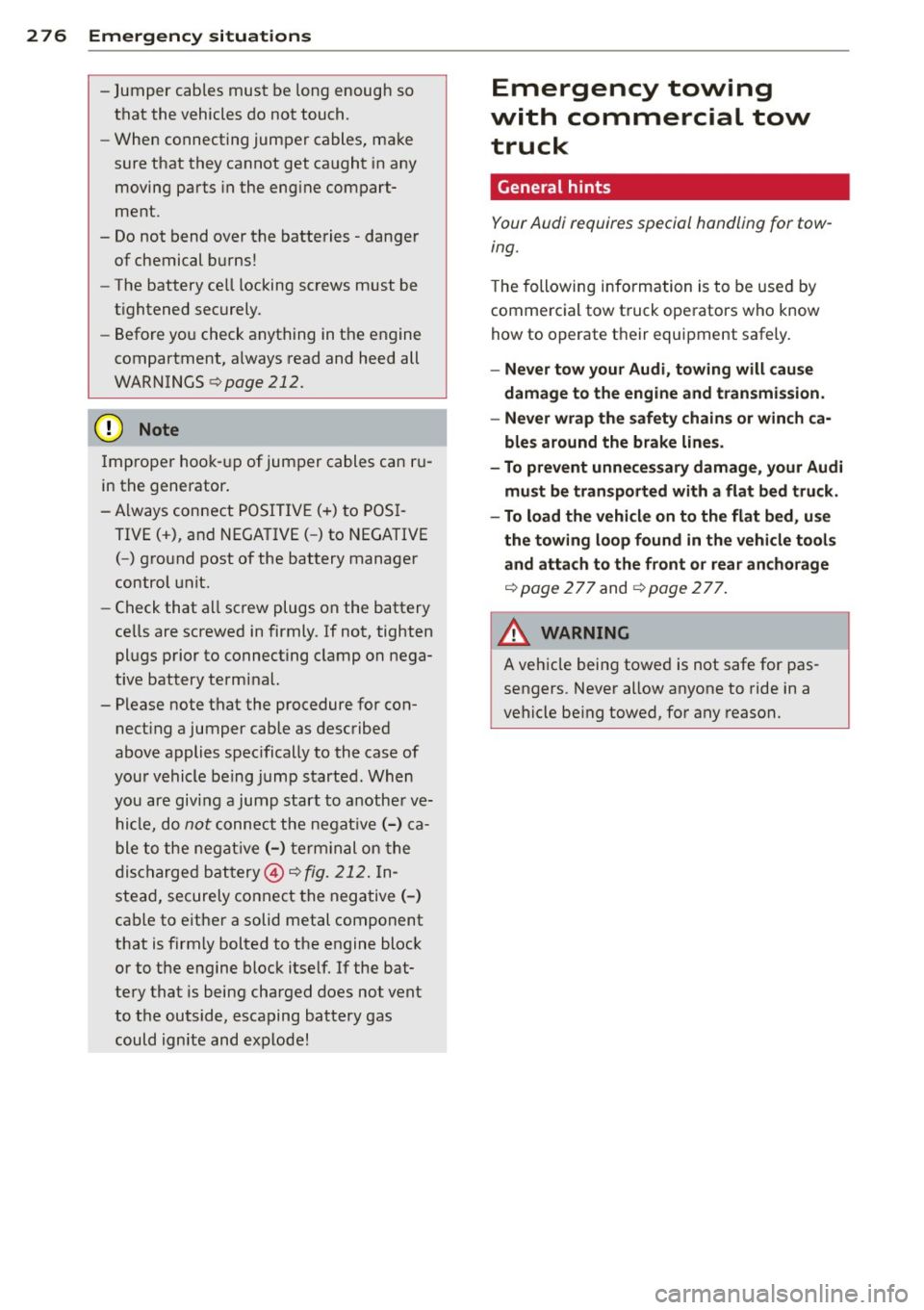
2 76 Em ergency sit uat ions
-Jumper cables must be long enough so
that the vehicles do not touch.
- When connecting jumper cables, make
sure that they cannot get caught in any
moving parts in the eng ine compart
ment.
- Do not bend over the batteries - danger of chemical burns!
- The battery ce ll locking screws must be
tightened securely .
- Before you check anything in the engine
compartment, always read and heed all
WARNINGS
9 page 212.
Improper hook-up of jumper cables can ru
in the generator.
- Always connect POSITIVE( +) to POS I
TIVE(+), and NEGATIVE( -) to NEGATIVE
( - ) ground post of the battery manager
control unit.
- Check that a ll screw plugs on the battery
cells are screwed in firmly . If not, tighten
plugs p rior to connecting clamp on nega
tive battery terminal.
- Please note that the procedure for con nect ing a jumper cable as described
above applies spec ifically to the case of
your vehicle being jump started. When
you are giving a jump start to another ve hicle, do
not connect the negat ive( -) ca
ble to the negat ive (-) term inal on the
discharged battery@)
9fig. 212. In
stead, securely connect the negative(- )
cable to e ither a solid metal component
that is firm ly bolted to the engine block
or to the engine block itself. If the bat
tery that is being charged does not vent
to the outside, escaping battery gas
could ignite and explode!
Emergency towing
with commercial tow
truck
General hints
Your Audi requires special handling for tow
ing.
T he following information is to be used by
commercial tow truck operators who know
how to operate their equipment safely.
- Nev er tow your Audi , towing will cau se
damage to the engine and tr an smi ssion .
- Ne ver wrap th e safety chain s or winch ca
ble s around the brak e lines.
- To pre vent unne ce ss ary dam age, your Audi
mus t be tr an sp o rt ed with a flat bed tru ck.
- To load th e vehicle on to th e flat b ed, use
the towing l oop found in t he vehicle to ols
a nd att ach to th e front or rea r a nchor age
c;,page 277 and c;,page 277 .
& WARNING
= -
A vehicle being towed is not safe for pas-
sengers. Never allow anyone to ride in a
vehicle being towed, for any reason.
Page 294 of 304
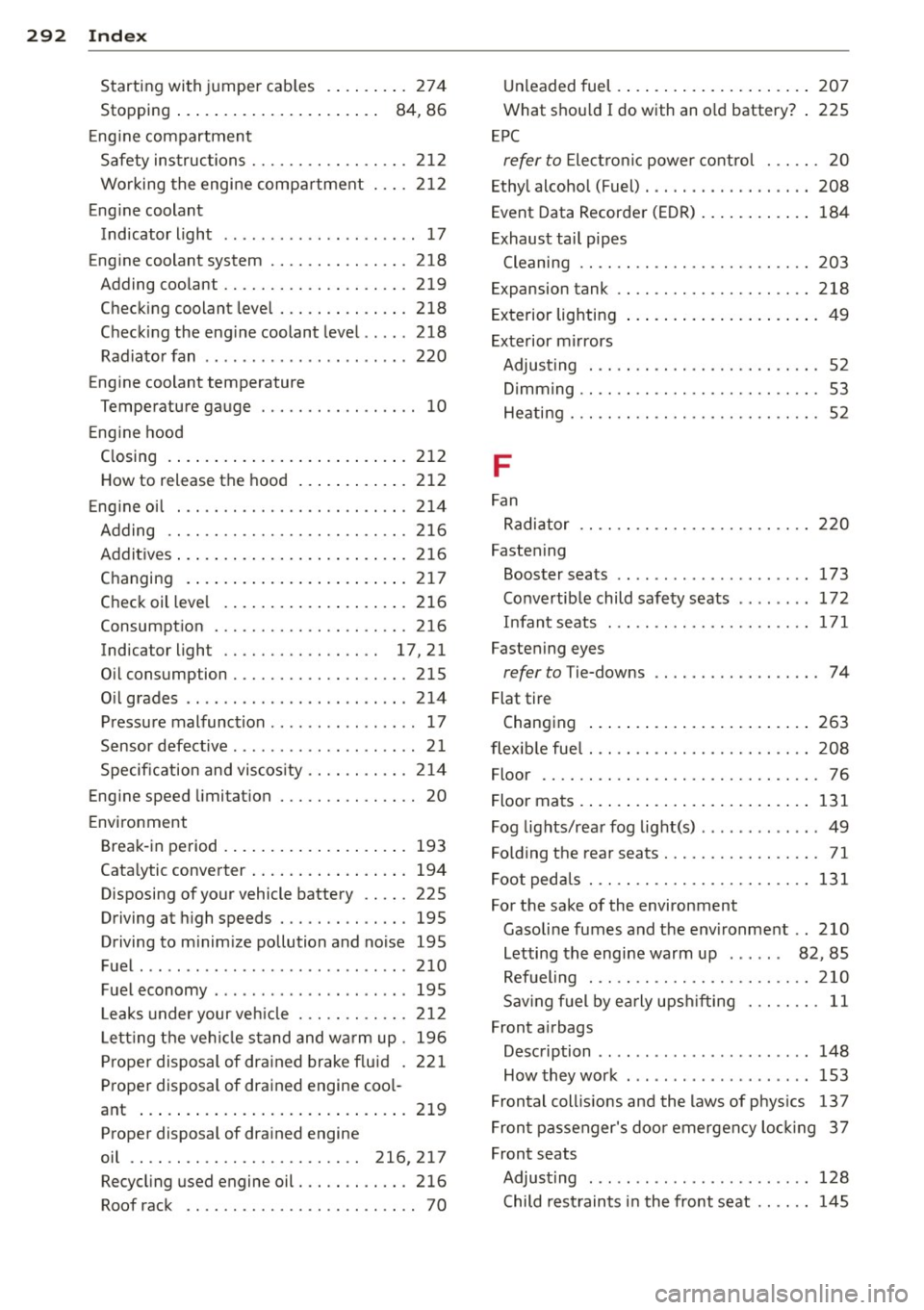
292 Index
Starting with jumper cab les . ....... . 274
Stopping . . . . . . . . . . . . . . . . . . . . . . 84, 86
E ng ine compartment
Safety instructions ...... .. .. .. .. .. . 212
Working the engine compartment 212
Eng ine coolant
Indicator light . . . . . . . . . . . . . . . . . . . . . 17
E ngine coolant system ...... .. .. .... . 218
Adding coolant ........... .. .. .. .. . 219
Checking coolant level ..... .. .. .. .. . 218
Check ing the eng ine coolant level .. .. . 218
Radiator fan .............. ... .. .. . 220
E ngine coolant temperature
Temperature gauge ....... .. .. .... .. 10
Engine hood
C losing ......... ......... ... .... . 212
How to release the hood ............ 212
E ng ine oil . .... ........... ........ . 214
Adding .. .. ............. .. .. .. .. . 216
Addit ives ... ................ ..... . 216
Changing . ................. ..... . 217
Check oil level ............ ... .... . 216
Consumption ............ .. .. .. .. . 216
Indicator light . . . . . . . . . . . . . . . . . 17, 21
Oil consumption ............ .. .... . 215
Oil grades .. ................ ... .. . 214
Pressure malfunction ...... .. .. .. .. . . 17
Sensor defective . . . . . . . . . . . . . . . . . . . . 21
Specification and viscos ity .. .. .. .... . 214
Engine speed limitation ......... .... .. 20
Environment Break- in period ............ ... .... . 193
Cata lytic converter ............ .. .. . 194
Disposing of your vehicle battery ..... 225
Driving at high speeds ..... .. .. .. .. . 195
Driving to minimize pollution and noise 195
Fuel ..... .. ..... ........... ... .. . 210
Fuel economy ............. ... .. .. . 195
L eaks under your veh icle . .. .. .. .. .. . 212
L ett ing the vehicle stand and wa rm up . 196
Proper disposal of drained brake fluid . 221
Proper disposal of drained engine coo l-
ant ..... .. ................ ..... . 219
Proper disposal of dra ined engine
oil .. .. .. ................. .. 216,217
Recycling used engine oil ... .. .. .. .. . 216
Roof rack . . . . . . . . . . . . . . . . . . . . . . . . . 70 Unleaded fuel
.... ................ . 207
What shou ld I do with an o ld battery? . 22S
EPC
refer to E lectronic power control . . . . . . 20
Ethyl alcohol (Fuel) . .. .. ...... ... .. .. 208
Event Data Recorder (EDR) ............ 184
Exhaust tail pipes
Cleaning .. .... .. ............. .... 203
Expansion tank .... ............. .... 218
Exterior lighting ... ................ .. 49
Exterior m irrors
Adjust ing . .. .. .. .. ........... .. .. . 52
Dimming .. .... .. ............. ..... 53
Heating . .. .. .. . .............. .. .. . 52
F
Fan
Radiator 220
Fastening Booster seats . . . . . . . . . . . . . . . . . . . . . 173
Convertib le child safety seats .. ... ... 172
Infant seats ... .. ... .......... .... 171
Fa stening eye s
refer to Tie-downs .. .... .... ... .. .. . 74
Flat tire Changing ..... .. ................ . 263
flexib le fue l ....... ............. .... 208
Floor .. .... .... .. ................. . 76
Floor mats . ..... .. ................ . 131
Fog lights/rear fog light(s) ......... ... . 49
Folding the rear seats ............ .... . 71
Foot pedals . .... .. ............. .... 131
For the sake of the environment Gasoline fumes and the env ironment .. 210
Letting the engine warm up . . . . . . 82, 85
Refueling . .. .. .. ... .......... .... 210
Sav ing fuel by early upshifting . .. .. .. . 11
Front airbags Description . . . . . . . . . . . . . . . . . . . . . . . 148
How they work . .. .......... ...... . 153
Frontal collisions and the laws of physics 137
Front passenger's door emergency lock ing 37
Front seats Adjusting ... .. .. ....... ...... .. .. 128
Child restraints in the front seat .. .. .. 145
Page 296 of 304
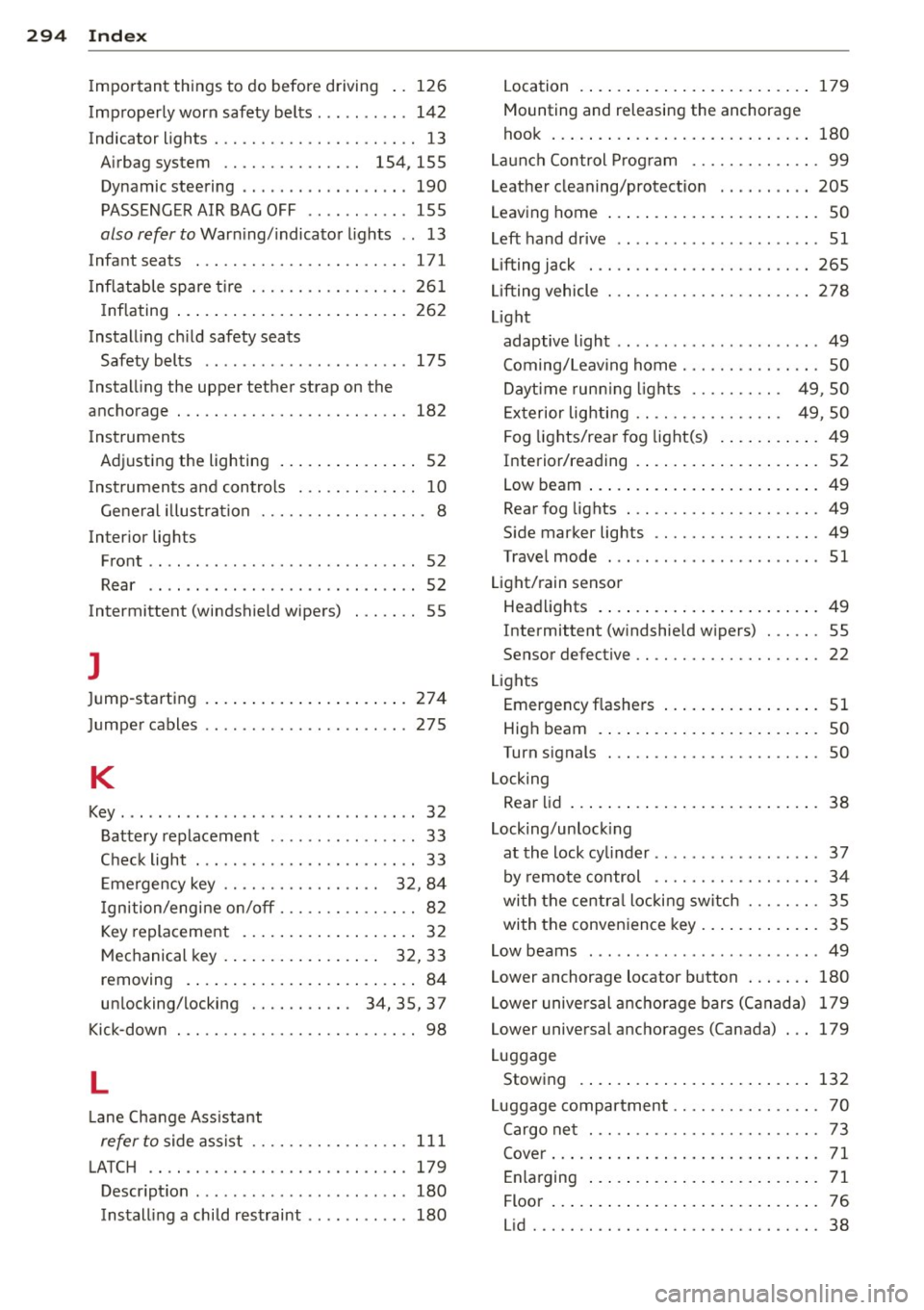
294 Index
Important things to do before driving .. 126
Improperly worn safety belts ..... .. ... 142
Indicator lights ............ .. .. .. .. .. 13
Airbag system . . . . . . . . . . . . . . . 154, 155
Dynamic steering ...... ... .. .. .. .. . 190
PASSENGER AIR BAG OFF ........ .. . 155
also refer to Warn ing/ indicator l ights .. 13
Infant seats . . . . . . . . . . . . . . . . . . . . . . . 171
I nflatable spare tir e ...... .. .. .. .. .. . 261
I nflating ........ ......... ... .... . 262
Installing ch ild safety seats
Safety belts .............. ... .. .. . 175
Installing the upper tether strap on the
anchorage . .. ............... .. .... . 182
I nstruments
Adjusting the lighting ........... .. .. 52
I nstruments and controls ... .. .. .. .. . . 10
General illustration ....... .. .. .. .. . .. 8
Interior lights Front .. .. .. ................ ... ... . 52
Rear .. .... .......... ...... ... .. .. 52
Intermittent (windshield wipers) . . . . . . . 55
J
Jump-starting .............. ... .... . 274
Jumper cables ................ ... ... 275
K
Key .... ... .. ................ ... .. .. 32
Battery replacement ...... .. .. .. .. .. 33
Check light ....... ..... .. .. .. .. .. .. 33
E mergency key . . . . . . . . . . . . . . . . . 32, 84
I gnition/engine on/off . . . . . . . . . . . . . . . 82
Key replacement ............. .... .. 32
Mechanical key . . . . . . . . . . . . . . . . . 32, 33
removing . . . . . . . . . . . . . . . . . . . . . . . . . 84
un locking/locking ........ .. . 34, 35, 37
Kick-down . . . . . . . . . . . . . . . . . . . . . . . . . . 98
L
Lane Change Ass istant
refer to side assist ........ .. .. .. .. . 111
LATC H .. .. .. ............. .. .. .. ... 179
Descr ipt ion .... .... ...... .. .. .. .. . 180
Install ing a child restraint ...... .. ... 180 Location
. . . . . . . . . . . . . . . . . . . . . . . . . 179
Mounting and releasing the anchorage
hook ............................ 180
Launch Control Program ......... .. .. . 99
Leather cleaning/protect ion .. .. .. .. .. 205
Leaving home ..... ................ .. 50
Left hand drive . . . . . . . . . . . . . . . . . . . . . . 51
Lifting jack . .... .. ............. .... 265
Lifting vehicle ... .. ............. .... 278
Light adaptive light . . . . . . . . . . . . . . . . . . . . . . 49
Coming/Leav ing home . . . . . . . . . . . . . . . 50
Daytime running lights . . . . . . . . . . 49, 50
Exterior lighting . . . . . . . . . . . . . . . . 49, 50
Fog lights/rear fog light(s) .......... . 49
Interior/reading . . . . . . . . . . . . . . . . . . . . 52
Low beam ..... .. ............. ..... 49
Rear fog lights ... ... .......... .. .. . 49
Side marker lights ............. .... . 49
Travel mode . . . . . . . . . . . . . . . . . . . . . . . 51
Light/rain sensor Headlights . ..... ................ .. 49
I ntermittent (windshield wipers) . .... . 55
Sen sor defe ctive . . . . . . . . . . . . . . . . . . . . 22
Lights
Emergency flashers . . . . . . . . . . . . . . . . . 51
High beam .... .. ................ .. 50
Tu rn signals ... ... ................ . 50
Locking Rear lid . . . . . . . . . . . . . . . . . . . . . . . . . . . 38
Locking/unlocking at the lock cylinder . . . . . . . . . . . . . . . . . . 3 7
by remote control . . . . . . . . . . . . . . . . . . 34
with the centra l locking switch ... .... . 35
with the conven ience key . . . . . . . . . . . . . 35
Low beams ..... .. ..... ........... .. 49
Lower anchorage locator button ....... 180
Lower universal anchorage bars (Canada) 179
Lower universal anchorages (Canada) 179
Luggage Stowing . ..... .. ............. .... 132
Luggage compartment ........... .. .. . 70
Cargo net ... .. .. ............. .. .. . 73
Cover ......... .. ................ .. 71
Enlarging . . . . . . . . . . . . . . . . . . . . . . . . . 71
Floor ......... .. ................ .. 76
Lid ....... .... .. ................. . 38